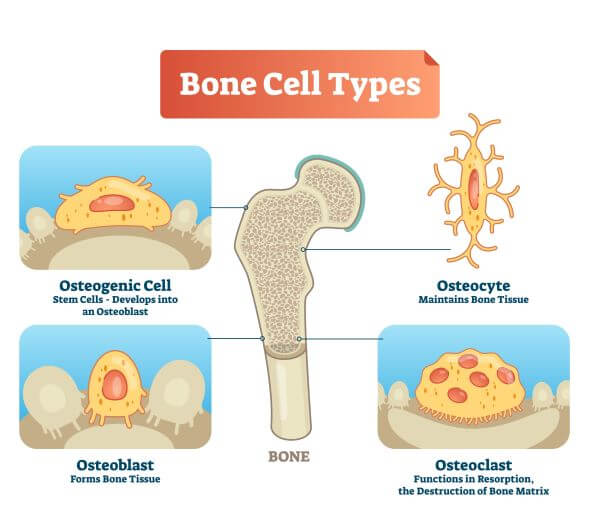1 Which of the Following Cells Produce New Bone
As stated above in adults the principal sites of red cell production called erythropoiesis are the marrow spaces of the vertebrae ribs breastbone and pelvis. Which of the following cells are NOT matched with its appropriate function.

Pin On Aplastic Anemia Disease Information
Chondrocytes enlarge and the surrounding matrix begins to calcify.

. Osteocytes permeate the interior of the bone and are produced from the fusion of mononuclear blood. Which body system that protects the organs of the body such as the heart lungs and brain. Serves as a splint across the fracture site.
Bone is composed of four different cell types. It produces new bone cell. Produce new bone cells.
C Mitosis limits the total number of cells in an organism which will change its shape. B-cell development is dependent on the nonlymphoid stromal cells of the bone marrow. Which of the following cells are NOT matched with its appropriate function.
It is the place where new blood cells are produced. Why is bone marrow important to the body. Red cells are produced continuously in the marrow of certain bones.
Which of the following cells produce new bone. Within the bone marrow the red cell is derived from a primitive precursor or erythroblast a nucleated cell in which there is no hemoglobin. Once the cluster of osteoblasts finishes its work the shape of osteoblasts gets flattened.
When a fracture is healing the procallus or fibrocartilaginous callus. When a bone breaks new bone is formed by which of the following bone cells. Mesenchymal cells are stem cells that can differentiate into various cell types such as osteoblasts chondrocytes myocytes and adipocytes.
Osteoblasts bone lining cells and osteoclasts are present on bone surfaces and are derived from local mesenchymal cells called progenitor cells. It produces red blood cell. Which of the following cells produce new bone.
Bone consists of four types of cells. Blood vessels invade the perichondrium. Stem cells isolated from the bone marrow and grown in culture fail to differentiate into B cells unless bone marrow stromal cells are also present.
Is made up of new bone b. 9 Test Bank Questionsdocx from BIO 271 at Grand Canyon University. Bone remodeling is a highly complex process by which old bone is replaced by new bone in a cycle comprised of three phases.
Each cell type has a unique function and is found in different locations in bones. It manufactures the blood cells in the body. Osteoblasts osteoclasts osteocytes and osteoprogenitor or osteogenic cells.
Once recruited osteoblasts produce the new bone matrix and promote its mineralization Formation phase thus completing the bone remodelling process Pre-OCLs pre-osteoclasts. It makes the bone strong. Stem cells from the bone marrow.
Osteoblasts work together in the form of clusters and perform their function of building up the bone. Maintain matrix D osteoclasts. B Sex cells are produced by mitosis which allows new organisms to be produced.
Perichondrial cells become osteoblasts and produce a thin. Stem cells from the bone marrow. The osteoblast the bone cell responsible for forming new bone is found in the growing portions of bone including the periosteum and endosteum.
Can bear weight c. Osteoblasts osteocytes osteoclasts and bone lining cells. Which of the following cells dissolve bone matrix to tear bone down so that is can be replaced with new stronger bone.
It stores much fat. B cells develop in the bone marrow with the help of stromal cells and achieve maturity in peripheral lymphoid organs. Bone-forming cells are called.
Osteoblasts replace calcified cartilage with spongy bone. Bone marrow contains two types of stem cells. Hemopoietic which can produce blood cells and stromal which can.
Bones are constantly undergoing resorption breaking bone down for. Osteoclast cells cause bone resorption and originate from a hematopoietic lineage which includes various blood cell types from within the bone marrow. If a bone is broken which of the following produces new bone tissue to heal the break.
B osteoblasts create new bone matrix C bone lining cells. Osteoblasts are made from mesenchymal stem cells MSC along with muscle cells myocytes and fat cells adipocytes. D Budding in yeast is an example of mitosis producing new multicellular organisms.
The following are important steps in the process of endochondral ossification. 1 initiation of bone resorption by osteoclasts 2 the transition or reversal period from resorption to new bone formation and 3 the bone formation by osteoblasts 10 11. Which of the following structures is not found in the central canal that travels along the center of the osteon.
Produce new bone cells. Which of the following cells produce new bone.
Microscopic Anatomy Bone Cells Structures Of Bones

12 Milestones In Medical History Infographic History Infographic History Education Medical History
Comments
Post a Comment